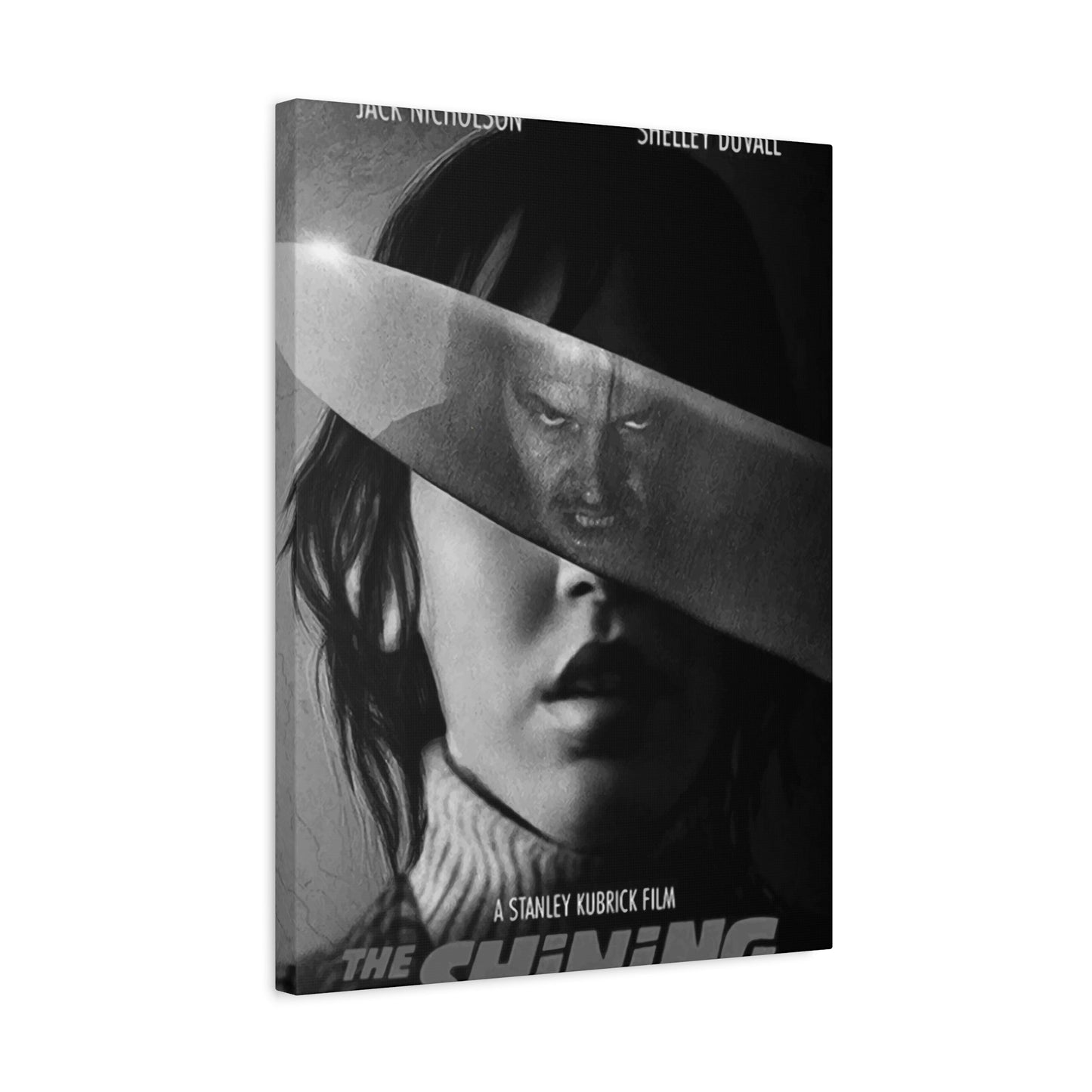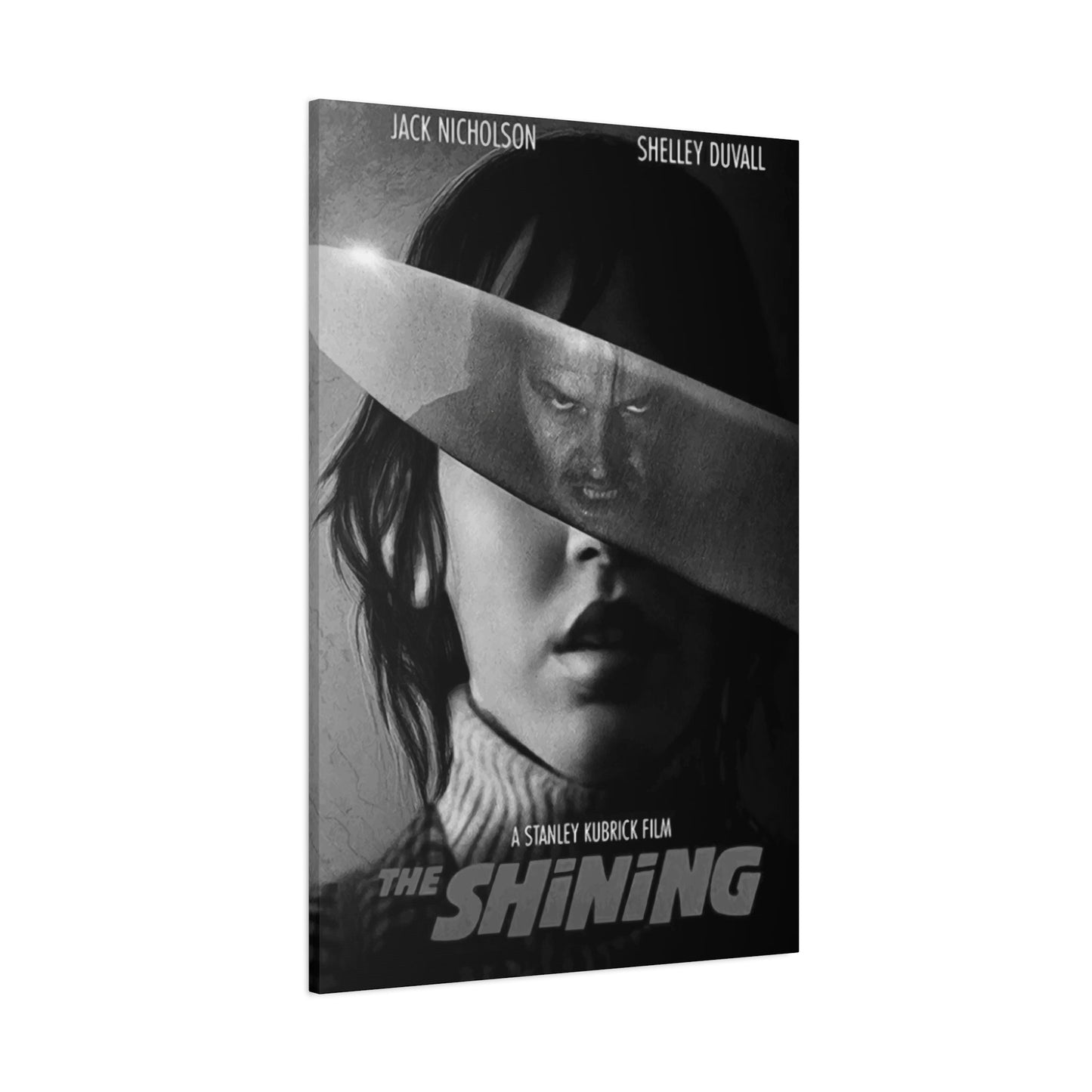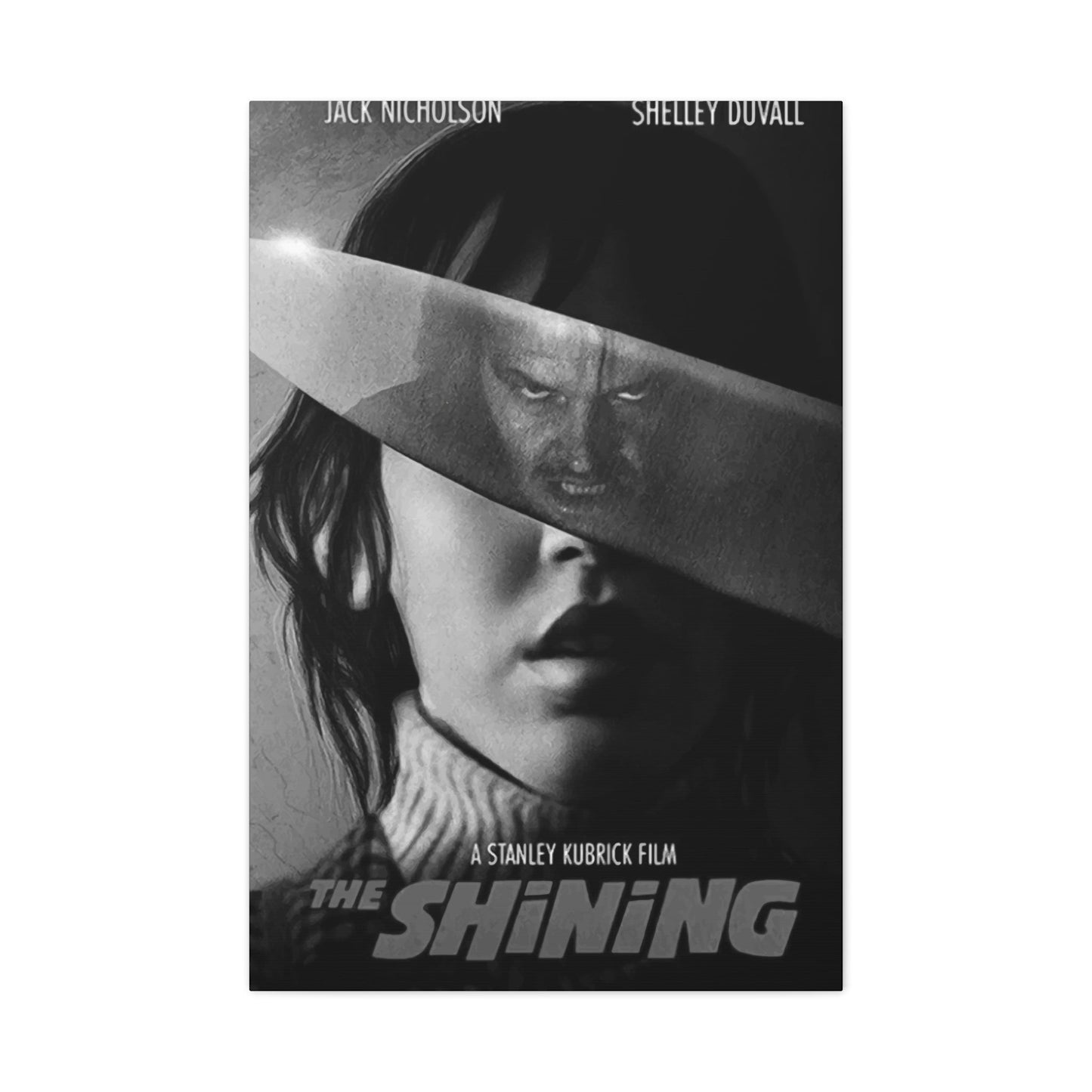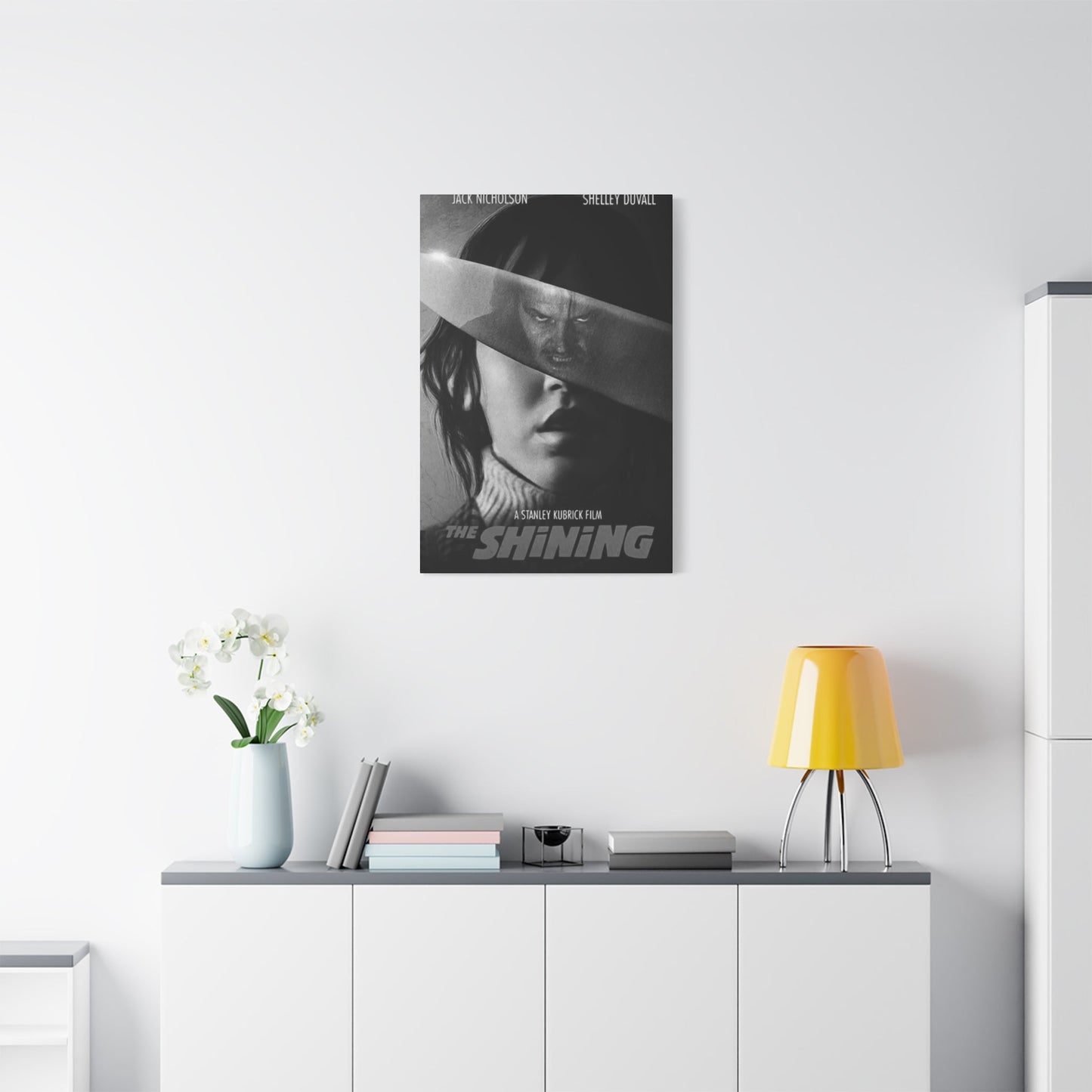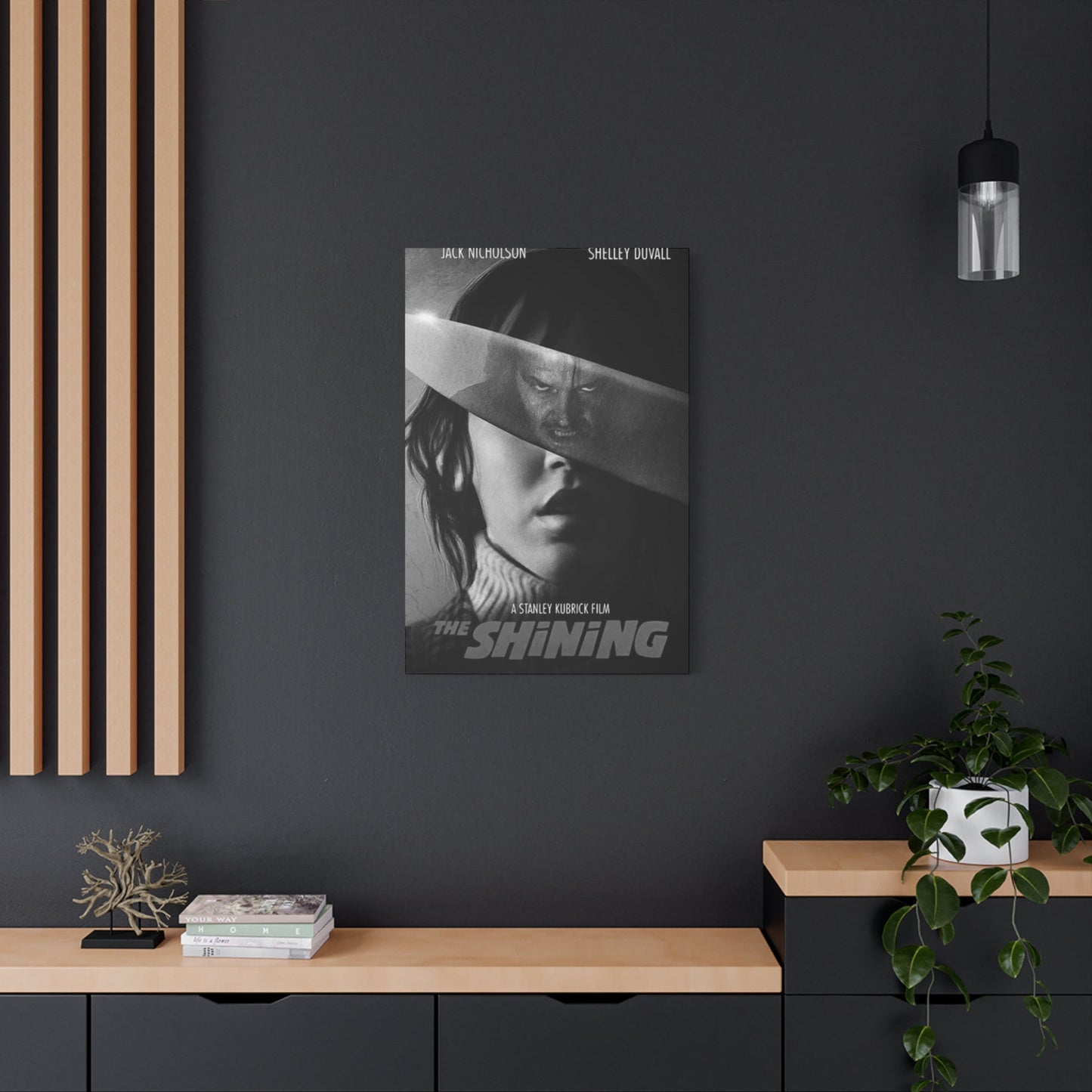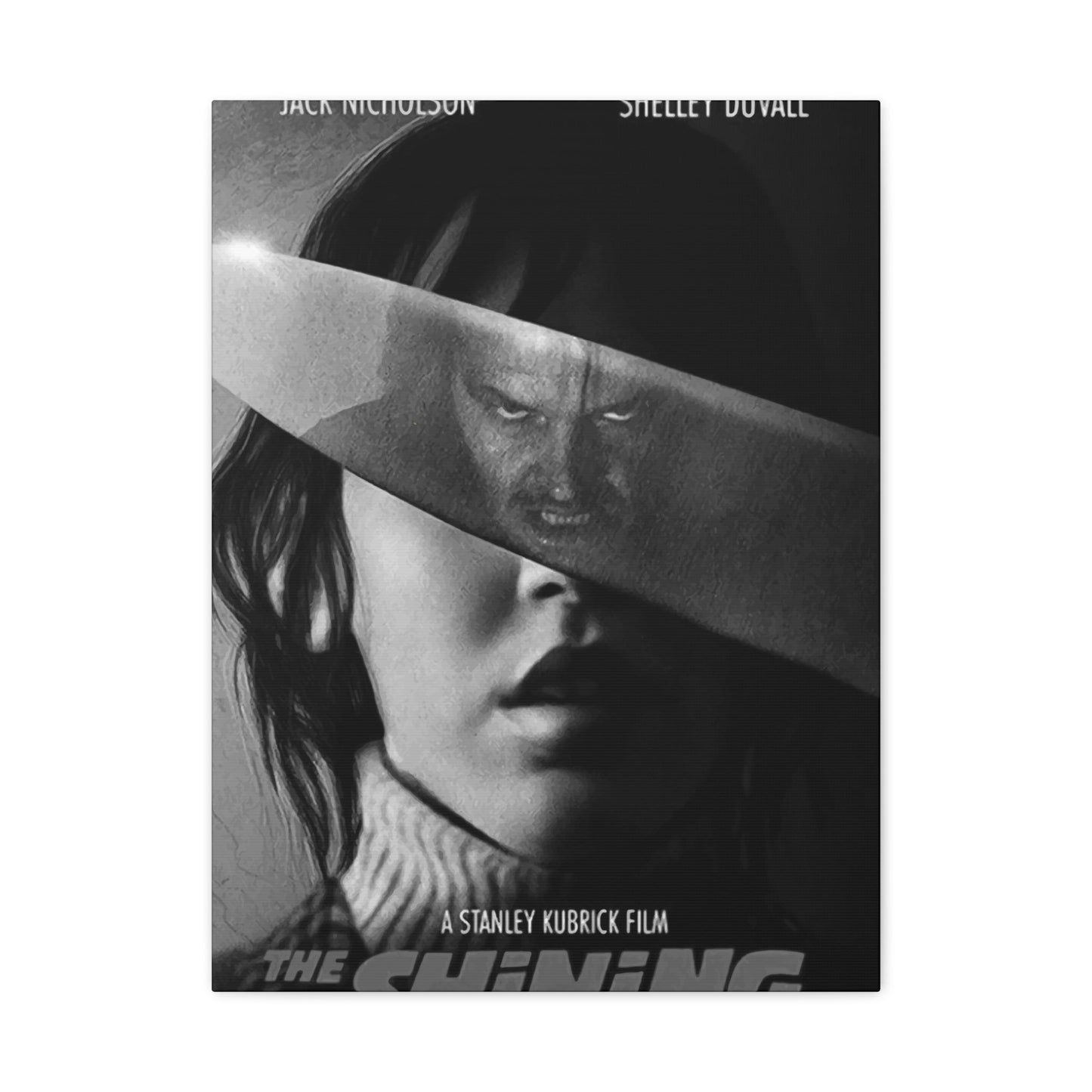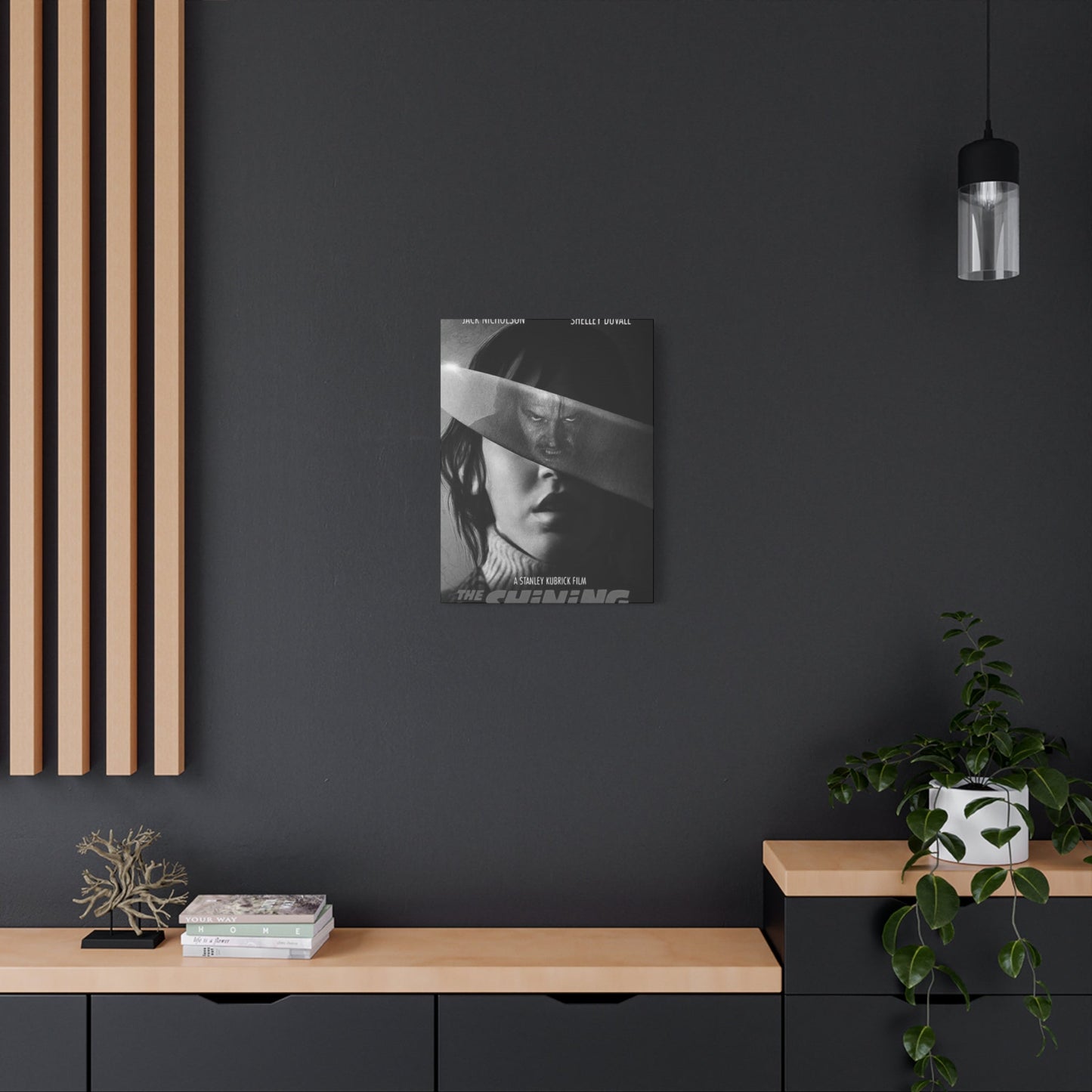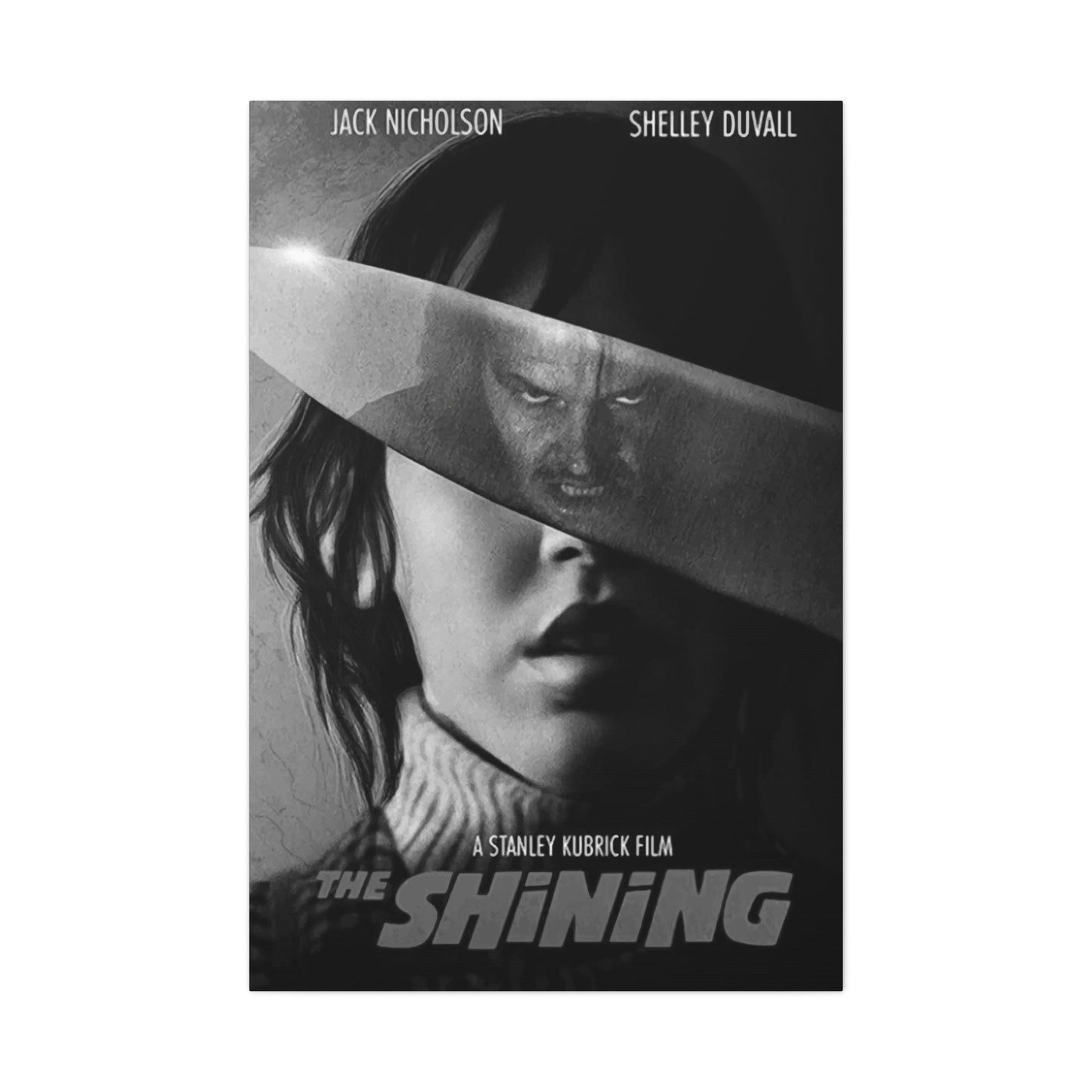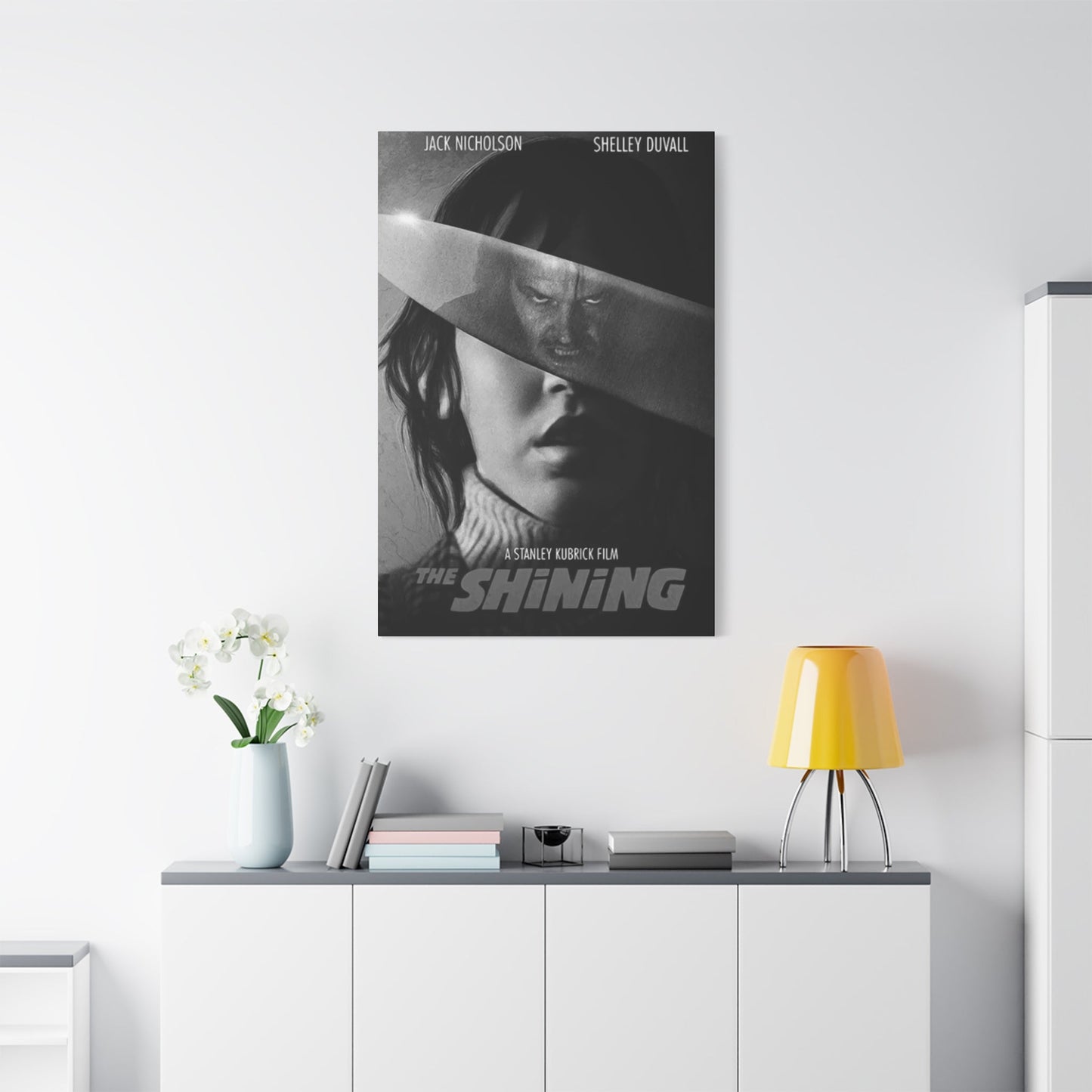Cinematic Classics at Home: Iconic Shining Movie Poster Wall Art Ideas
When it comes to creating a space that reflects your passion for cinema, few pieces make a statement quite like a carefully chosen movie poster. The famous scene where Jack Nicholson breaks through the bathroom door has become one of the most recognizable moments in film history. This particular image captures raw intensity and psychological terror in a single frozen moment. When you place this artwork on your wall, you're not just hanging a decoration; you're inviting a piece of cinematic excellence into your daily environment.
The power of this imagery lies in its ability to evoke immediate recognition. Anyone who walks into your room will instantly connect with the cultural significance of what they're seeing. The wild expression, the splintered wood, and the sheer madness captured in that frame create an unforgettable visual impact. This type of decor serves multiple purposes simultaneously. It functions as a conversation starter, a personal statement about your film preferences, and an artistic element that adds character to otherwise plain walls.
What makes this particular piece so effective as wall art is its composition. The framing of the scene, the lighting, and the expression all combine to create something that works both as a reference to the source material and as a standalone piece of visual art. You don't need to explain its significance to true film enthusiasts because they'll recognize it immediately. Yet even those unfamiliar with the original work can appreciate the dramatic intensity captured in the image.
Placing such iconic imagery in your personal space creates an atmosphere that reflects your appreciation for cinematic artistry. The choice speaks volumes about your taste and your willingness to embrace bold decorative decisions. Unlike generic wall art that fills space without adding meaning, this type of poster transforms your environment into something more personal and expressive.
Add Horror History to Your Decor
The genre of psychological thriller and suspense has produced some of the most visually striking imagery in cinema history. When you choose to incorporate these elements into your living space, you're tapping into decades of artistic evolution and storytelling excellence. These films have shaped how we think about fear, tension, and human psychology. The visual language developed through these works has influenced countless other productions and has become an integral part of our cultural vocabulary.
Horror history encompasses far more than simple scares or gore. The best examples of the genre explore complex themes about human nature, isolation, and the breaking points of sanity. When you display artwork from these films, you're acknowledging this deeper artistic merit. You're celebrating films that have pushed boundaries and challenged audiences to confront uncomfortable truths about themselves and the world around them.
The evolution of horror cinema has given us an incredible range of visual styles to choose from. From the stark black and white aesthetics of early gothic films to the vibrant, stylized imagery of modern productions, each era has contributed unique artistic approaches. When selecting pieces for your collection, consider how different periods and styles can complement each other. A well-curated selection can tell a story about the development of the genre itself.
Creating a space that honors horror history requires thoughtful consideration of which pieces truly represent the pinnacle of the genre. Not every scary movie deserves wall space, but those that have genuinely innovated or perfected certain aspects of filmmaking certainly do. Look for images that capture the essence of what made particular films groundbreaking. Consider the cinematography, the use of color or shadow, and the way certain scenes have been composed to create maximum impact.
Iconic Fear, Framed in Style
The intersection of terror and artistic presentation creates something uniquely powerful in the realm of wall decoration. When fear is captured and presented with stylistic intention, it transcends its initial purpose and becomes something you can appreciate on multiple levels. The best examples of this achieve a balance between being unsettling and being aesthetically pleasing. They make you feel something while simultaneously impressing you with their visual composition.
Framing plays a crucial role in how these images are perceived in your space. The right frame can elevate a poster from a simple print to a genuine piece of art. Consider frames that complement the era and style of the image itself. A vintage-style film might benefit from a classic wooden frame with subtle detailing, while a more modern production might look best in something sleek and minimalist. The frame becomes part of the overall presentation and should enhance rather than distract from the central image.
The concept of iconic fear is about images that have become so deeply embedded in our collective consciousness that they carry meaning beyond their original context. These are the moments that define entire films or even entire careers. When directors and cinematographers create these scenes, they're often aware that they're crafting something that will endure beyond the theater experience. The most successful examples become cultural touchstones that people reference and remember decades later.
Displaying these moments in your home creates a unique dynamic. Unlike positive or neutral imagery, pieces that evoke fear or unease create a specific atmosphere in the space they occupy. This can be exactly what you're looking for if you want your environment to feel distinctive and memorable. Guests will remember a room decorated with bold, slightly unsettling imagery far more than they'll remember generic landscapes or abstract prints.
Classic Cinema Meets Wall Art
The golden age of filmmaking produced countless moments worth preserving and displaying. When classic cinema is translated into wall art, it bridges the gap between historical appreciation and contemporary decoration. These pieces serve as reminders of filmmaking techniques and storytelling approaches that have influenced everything that came after. They represent a time when practical effects, careful lighting, and methodical direction were essential tools of the trade.
Classic cinema wall art works in nearly any decorating scheme because it carries an inherent sophistication. Black and white images especially have a timeless quality that transcends temporary design trends. They can fit into vintage-inspired spaces, modern minimalist rooms, or eclectic collections with equal effectiveness. The monochromatic palette often makes these pieces easier to coordinate with existing color schemes while still making a strong visual statement.
When you choose to display artwork from classic films, you're participating in the preservation of film history. Many younger viewers may not be familiar with older productions unless they're actively introduced to them. Having these images visible in your space can spark curiosity and lead to conversations about film history and evolution. You become a curator of sorts, selecting which moments and which films deserve continued recognition and appreciation.
The artistry involved in classic cinema was often more deliberate and carefully constructed than what we see in the age of digital filmmaking. Directors had to get shots right in camera because extensive post-production manipulation wasn't an option. This necessity led to incredibly thoughtful composition and planning. When you display images from these films, you're showcasing this intentionality. Every element in the frame was placed there for a reason, and that level of craftsmanship is worth celebrating.
Redrum Looks Good in Red Ink
Typography and color choice can transform simple words into powerful visual elements. The backwards spelling that appears in one of cinema's most famous films has become an iconic image in its own right. When rendered in bold red lettering, it creates an immediate sense of unease and recognition. This demonstrates how effective design principles can take something as basic as text and turn it into compelling artwork.
Red ink has psychological associations that make it particularly effective for horror-themed decor. The color naturally evokes thoughts of danger, passion, and violence. When used deliberately in artwork, it creates an immediate emotional response. This is why so many effective posters and prints use red as a dominant or accent color. It draws the eye and creates the mood simultaneously.
The mirror writing concept adds another layer of intrigue to this particular design element. It suggests hidden meanings and inverted realities, themes that run throughout the source material. When you display text-based artwork like this, you're presenting something that works on multiple levels. It's visually striking, culturally significant, and conceptually interesting. People will spend time looking at it, trying to parse out the meaning if they're unfamiliar with the reference.
Typography-focused posters have become increasingly popular in recent years because they offer a cleaner, more minimalist approach to film-inspired decor. Instead of literal representations of scenes or characters, these pieces distill the essence of a work down to its most memorable phrases or concepts. This approach can be particularly effective if you prefer a less cluttered aesthetic but still want to express your enthusiasm for particular films.
Stanley Kubrick's Masterpiece, Poster Perfect
Directors who have truly mastered their craft deserve recognition, and displaying their work is one way to honor their contributions to cinema. One particular filmmaker stands out for his meticulous attention to detail, innovative techniques, and ability to create visually stunning compositions. His films have been analyzed, studied, and celebrated for decades, and they continue to influence contemporary filmmakers.
This director's approach to every aspect of production was famously exacting. He would shoot dozens or even hundreds of takes to achieve exactly what he envisioned. This perfectionism resulted in films where every frame could function as a standalone photograph. When you choose artwork from these productions, you're selecting from material that was crafted with extraordinary care and intention. Each image represents countless hours of planning and execution.
The visual style developed across this director's body of work is immediately recognizable. The use of symmetry, the specific color palettes, the careful framing, and the deliberate camera movements all create a distinctive aesthetic. Posters and prints that capture these elements become more than just movie memorabilia; they become examples of a singular artistic vision. They demonstrate what's possible when someone has complete creative control and uses it to push boundaries.
Displaying artwork from this filmmaker's productions signals to visitors that you appreciate cinema as an art form rather than just entertainment. These are films that reward multiple viewings and careful analysis. They contain layers of meaning and symbolism that people continue to discover and debate. When you put these images on your wall, you're aligning yourself with a tradition of thoughtful film appreciation.
The Ultimate Horror Art Statement
Making a strong statement with your decor requires confidence and commitment to your chosen aesthetic. Horror-themed artwork makes one of the boldest statements possible because it deliberately embraces imagery that many people avoid. This isn't about shocking guests or being provocative for its own sake; it's about creating an environment that reflects genuine enthusiasm for a specific genre and artistic tradition.
The statement you make with horror art extends beyond simple decoration. It communicates that you're someone who appreciates complexity and doesn't shy away from darker themes. The best horror films explore profound questions about human nature, morality, and the fragility of sanity. Displaying artwork from these films shows that you engage with these ideas and find value in stories that challenge comfortable assumptions.
Creating an impactful display requires careful curation. Too many pieces can make a space feel cluttered and reduce the individual impact of each item. Consider which images truly resonate with you and which ones best represent the aspects of the genre you most appreciate. Quality matters more than quantity. A single powerful piece properly displayed will make a stronger impression than a wall covered in mediocre prints.
The placement of horror artwork within your space also contributes to the overall effect. Consider which rooms will benefit most from these pieces. A home theater or entertainment area is an obvious choice, but don't overlook other possibilities. A hallway can become dramatically more interesting with the right artwork. Even a bathroom can accommodate smaller pieces if they're properly protected from moisture. Think about the experience you're creating as people move through your space.
Shining Poster for True Film Fans
Genuine enthusiasm for cinema goes beyond casual viewing. True film fans develop deep knowledge about productions, directors, actors, and the history of the medium itself. They recognize quality craftsmanship and can articulate what makes certain films superior to others. When you display artwork that references acknowledged masterpieces, you're identifying yourself as part of this community of serious appreciators.
The film in question has achieved a status that few productions ever reach. It's studied in film schools, analyzed in academic papers, and referenced constantly in popular culture. Decades after its release, it continues to find new audiences and inspire contemporary filmmakers. A poster representing this work carries all of this cultural weight. It's not just decoration; it's a piece of film history.
What separates casual viewers from dedicated fans is the willingness to engage with challenging material. This particular film isn't easy or comfortable. It demands attention and rewards careful viewing. It doesn't provide simple answers or neat resolutions. When you display artwork from productions like this, you're showing that you value substance and complexity over simple entertainment. You're willing to sit with discomfort and ambiguity in service of a richer artistic experience.
Building a collection focused on acclaimed and influential films creates opportunities for ongoing discovery. As you learn more about film history and theory, you'll develop a deeper appreciation for what you already own. You'll notice details in familiar images that you missed before. You'll understand references and influences that weren't apparent initially. Your collection becomes not just a decorative element but an ongoing education in cinema.
Vintage Vibes, Chilling Presence
The aesthetic of vintage design has experienced a major resurgence in recent years as people seek alternatives to the sleek, minimalist styles that have dominated for so long. Vintage-inspired pieces offer warmth, character, and a sense of history that newer designs often lack. When combined with chilling subject matter, this creates a fascinating tension that makes the artwork even more compelling.
Original vintage posters from the era of a film's initial release have become valuable collectibles, but high-quality reproductions can capture much of the same appeal at a fraction of the cost. These reproductions often use printing techniques and paper stocks that mimic the look and feel of authentic vintage materials. The result is artwork that looks like it could have been hanging in a theater lobby decades ago.
The color palettes used in vintage poster design were often dictated by the printing limitations of the time. This resulted in distinctive looks that modern designers now deliberately reference and recreate. The slightly faded appearance, the particular shades of color, and the grain of the paper all contribute to the vintage aesthetic. When this style is applied to horror and thriller imagery, it creates an interesting contrast between the nostalgic form and the unsettling content.
Incorporating vintage-style pieces into contemporary spaces requires some consideration of how they'll interact with modern elements. Rather than trying to create a completely period-accurate environment, most people find success in mixing vintage pieces with contemporary furniture and accessories. The contrast between old and new can actually enhance both, creating a layered, collected-over-time appearance that feels more personal than a perfectly coordinated design scheme.
Twin Terror, Timeless Design
Certain images from cinema history have achieved such iconic status that they transcend their original context and become pure visual symbols. The image of identical twins standing in a hallway is one of these. Even people who haven't seen the source material recognize this image and associate it with a sense of unease and wrongness. This is the power of truly effective visual design paired with strong cinematic execution.
The concept of twins in horror goes back centuries in folklore and literature. There's something inherently unsettling about perfect human duplication. It taps into deep psychological responses about identity, individuality, and the natural order of things. When filmmakers use this trope effectively, they're accessing these primal responses. The particular execution in this famous film has become the definitive example of how to use twin imagery for maximum impact.
From a design perspective, this image works because of its stark simplicity. The composition is straightforward and symmetrical, which actually enhances rather than diminishes its disturbing quality. The matching dresses, the identical postures, the empty hallway creating negative space around the figures—all of these elements combine to create something memorable and effective. As wall art, this translates well because the image is so clean and graphic.
Timeless design doesn't chase trends or try to be contemporary. Instead, it focuses on fundamental principles of composition, balance, and emotional impact that remain effective regardless of changing fashions. When you invest in pieces with timeless appeal, you're choosing artwork that will remain relevant and impactful for years or even decades. You won't need to replace these pieces when design trends shift because they exist outside of those temporary movements.
Make Your Walls Scream Style
Decorating should be an expression of personality rather than an exercise in following prescribed rules. When you commit to a bold aesthetic choice, you're prioritizing individual expression over generic appeal. Horror-themed decor certainly qualifies as a bold choice, and when done well, it demonstrates confidence and creative vision. Your walls become a canvas for expressing your interests and taste.
Style is about more than just selecting attractive items. It's about creating a cohesive vision and executing it with intention. When planning horror-themed decor, consider how different pieces will work together. Think about color coordination, frame styles, and the overall mood you want to create. Even within a specific genre, there's room for variety in approach. Some pieces might be more graphic and intense, while others might be more subtle and atmospheric.
The arrangement of artwork on your walls deserves as much thought as the selection of the pieces themselves. Consider creating gallery walls where multiple pieces work together to tell a story or create a larger impact. Think about the height at which you hang items—eye level is standard, but breaking this rule deliberately can create interesting effects. Pay attention to spacing between pieces and how they relate to furniture and other elements in the room.
Making your walls scream style also means knowing when to exercise restraint. Not every surface needs to be covered, and negative space can be just as important as the artwork itself. Sometimes a single dramatic piece on an otherwise bare wall creates more impact than a cluttered arrangement. Trust your instincts about when you've achieved the right balance. If a space feels too busy or overwhelming, removing items is always an option.
Cult Classic Decor Done Right
Cult classics occupy a special place in film culture. These are productions that may not have achieved immediate mainstream success but have developed devoted followings over time. They represent films that dare to be different, that take risks, and that often challenge conventional storytelling or stylistic approaches. Decorating with imagery from cult classics demonstrates an appreciation for innovation and originality.
What makes a film a cult classic is often its willingness to be divisive. These aren't movies that try to appeal to everyone. They have strong points of view and distinctive styles that attract passionate fans while leaving others indifferent or even hostile. When you display artwork from these films, you're aligning yourself with the passionate fans. You're part of a community that recognizes and celebrates what makes these works special.
Done right, cult classic decor balances reverence for the source material with effective design principles. The goal is to create something that works as art in your space while still honoring what makes the film significant. This might mean choosing more subtle or artistic representations rather than the most obvious images. It might mean focusing on thematic elements or color palettes rather than literal depictions of scenes or characters.
Building a collection around cult classics allows for more variety than sticking to mainstream blockbusters. You can explore different eras, different genres, and different international film traditions. This creates opportunities to discover lesser-known works and to develop a more sophisticated understanding of cinema history. Your collection becomes a reflection of genuine exploration and discovery rather than simply following popular opinion.
All Work and No Art? Fix That
Creating a living or working space that lacks personal touches and artistic elements can feel sterile and unwelcoming. Bare walls suggest a temporary situation or a lack of investment in the space. While minimalism has its place, taking it to the extreme of having no artwork at all usually results in environments that feel incomplete rather than intentionally spare.
The famous phrase from the typewriter pages has become shorthand for descending madness and obsessive repetition. But it also serves as a humorous reminder that balance is necessary in life. All work and no play—or in this case, no art—creates an environment that doesn't support creativity or wellbeing. Adding artwork, especially pieces you genuinely connect with, transforms a space from purely functional to truly livable.
Fixing the problem of bare walls doesn't require a massive investment or complete redesign. Start with one or two significant pieces that really speak to you. Place them thoughtfully and live with them for a while before deciding what else the space might need. Building a collection gradually often results in better outcomes than rushing to fill every wall at once. You'll make better choices when you take time to consider what really works in your specific environment.
The type of art you choose has a significant impact on how a space feels. Dark, intense imagery creates a very different atmosphere than light, cheerful designs. Neither is inherently better, but they serve different purposes and create different experiences. If you spend a lot of time working in a space, consider whether you want your art to energize you, calm you, or remind you of things you're passionate about outside of work. Let these considerations guide your selections.
Bold Posters for Brave Collectors
Collecting requires courage, especially when your interests lie outside of mainstream taste. Horror and thriller artwork isn't what most people think of when they consider traditional collectibles. But that's exactly what makes building this type of collection interesting. You're carving out your own niche and defining value according to your own criteria rather than following established collecting conventions.
Bold posters make statements that more subtle pieces cannot. They command attention and dominate the spaces they occupy. This isn't background art that fades into the environment. These are pieces that people notice, remember, and often want to discuss. If you're going to collect bold pieces, you need to be comfortable with the attention they'll attract and prepared to discuss your choices.
Being a brave collector means sometimes investing in pieces that others might not understand or appreciate. It means trusting your own judgment about what has value and meaning. It means being willing to display things that might make some visitors uncomfortable. This isn't about being contrarian for its own sake; it's about having the confidence to honor your genuine interests even when they don't align with conventional taste.
The community of horror and cult film collectors is passionate and knowledgeable. Engaging with other collectors can enhance your appreciation and understanding of what you own. Online forums, social media groups, and conventions provide opportunities to connect with like-minded enthusiasts. These communities can also be valuable resources for finding rare pieces, learning about new releases, and discovering aspects of films you may have missed.
Revisit Room 237 with Every Glance
Certain elements within films take on lives of their own, becoming subjects of endless discussion and interpretation. A particular room number has spawned countless theories and analyses. People have written entire books exploring the possible meanings and symbolism associated with this space. When you display imagery related to these heavily-analyzed elements, you're participating in an ongoing conversation about meaning and interpretation.
The beauty of ambiguous symbolism is that it invites personal interpretation. There's no single correct way to understand these elements, which means your relationship with the artwork can evolve over time. What you notice or think about when looking at a piece may change as you age, as you rewatch the source material, or as you learn about different interpretive frameworks. The artwork becomes a prompt for reflection rather than just a static image.
Revisiting familiar imagery regularly can reveal details you missed initially. The human brain is pattern-seeking and tends to notice different things on repeated viewings. When artwork is present in your daily environment, you have countless opportunities for these micro-discoveries. You might notice a color relationship you hadn't consciously registered before. You might suddenly understand a compositional choice. These small revelations keep the artwork fresh and engaging.
Creating spaces that reward repeated attention is good design practice. Rather than relying on immediate, obvious impact that quickly becomes stale, thoughtful artwork continues to offer new things to appreciate over time. This is especially true of pieces drawn from films that themselves contain layers of meaning. The artwork becomes a gateway back into the full experience of the film, triggering memories and associations each time you encounter it.
The Shining Poster: Creepy and Cool
The balance between unsettling and appealing is difficult to achieve but incredibly effective when successful. Artwork that leans too far toward disturbing becomes difficult to live with and may alienate guests. Artwork that's too safe and comfortable fails to create the distinctive atmosphere that makes horror-themed decor interesting. The sweet spot is imagery that makes you feel something while remaining aesthetically pleasing.
Creepy and cool occupy different spaces on the emotional spectrum, and combining them creates interesting tension. Creepy suggests something off-putting or uncomfortable, while cool implies social approval and aesthetic success. When both qualities exist simultaneously, the result is compelling in a way that purely positive or purely negative imagery cannot match. This duality makes people want to keep looking even if they're not entirely comfortable with what they're seeing.
Posters that achieve this balance often do so through strong design fundamentals. The composition is pleasing even if the subject matter is disturbing. The color palette works well even if it's being used to create unease. The typography is effective even if the words spell out something ominous. These pieces succeed as design objects while simultaneously functioning as references to beloved films.
Living with creepy yet cool artwork requires a certain self-awareness. You need to understand your own tolerance for darker imagery and be honest about whether a piece will enhance your daily life or eventually become oppressive. What seems exciting and edgy when you first hang it might feel different after months of daily exposure. Choose pieces that have enough artistic merit and design quality to remain appealing even as the initial novelty wears off.
Elevate Your Space with Iconic Cinema
Elevation in decor terms means raising the perceived sophistication and intentionality of your environment. Generic mass-market art from furniture stores or big box retailers doesn't elevate a space; it just fills it. Iconic cinema artwork, on the other hand, brings cultural significance and artistic pedigree that genuinely enhances your environment. It shows that you've put thought into your choices and that you value quality and meaning.
Cinema represents one of the major art forms of the modern era. Like painting, sculpture, or literature, it's a medium through which artists express ideas and create experiences that resonate across time and culture. When you display artwork derived from significant films, you're connecting your space to this larger cultural conversation. You're demonstrating awareness of and engagement with important artistic works.
The iconic nature of certain films and images means they carry instant recognition and associations. This shared cultural knowledge creates connections between you and visitors who recognize and appreciate the references. These aren't obscure inside jokes that only a handful of people will understand. These are touchstones that millions of people have experienced and remember. The artwork becomes a way to find common ground and start meaningful conversations.
Elevating your space doesn't mean making it formal or stuffy. Cinema artwork, especially from genres like horror and thriller, can create sophisticated environments while maintaining approachability and personality. The key is in the presentation—quality frames, thoughtful placement, and integration with the rest of your design scheme. When done well, the result is a space that feels curated and intentional without being precious or unapproachable.
Jack Torrance, Frozen in Time
Characters who deliver unforgettable performances become immortalized in cultural memory. The descent into madness portrayed by one particular actor has become the definitive example of a specific type of psychological breakdown on film. The physicality, the vocal delivery, and the gradual transformation from family man to something far more dangerous created a character that people still reference decades later.
Freezing a moment in time through photography or artwork allows us to preserve and revisit significant instances. In film, certain frames or scenes crystallize the essence of an entire character arc. When these moments are extracted and presented as standalone images, they carry the weight of everything that led to that instant and everything that follows. A single image can encapsulate an entire performance and story.
The specific moment captured in the most famous scene involving this character has become one of the most parodied and referenced images in cinema history. This level of cultural penetration means that the image works on multiple levels simultaneously. It's a serious piece of film history, a recognizable pop culture icon, and a source of countless homages and jokes. This multiplicity of meanings adds richness to the experience of displaying the artwork.
Characters frozen in their most intense or significant moments remind us of the power of performance and storytelling. They demonstrate how actors can create something that outlasts their involvement with a project. The character takes on a life independent of the performer, existing in the cultural consciousness as a distinct entity. When you display these iconic character moments, you're celebrating the collaborative art of cinema—the combination of writing, directing, performing, and technical execution that creates these memorable instances.
Perfect for Horror-Themed Rooms
Designing a room around a specific theme requires commitment and attention to detail. A horror-themed space isn't something you create halfway—it needs enough elements reinforcing the concept to feel intentional rather than accidental. Movie posters provide an excellent foundation for this type of design because they're bold, recognizable, and available in a wide range of styles and eras.
The advantage of dedicating an entire room to horror theming is that you can fully embrace darker colors, dramatic lighting, and atmospheric elements that might be overwhelming if applied to your entire home. A media room, home theater, game room, or personal office can become a space where you fully indulge your appreciation for the genre. This allows other areas of your home to maintain broader appeal while still giving you a space that's entirely your own.
Color schemes in horror-themed rooms often emphasize deep reds, blacks, and grays, though there's certainly room for variation. Some horror films use very different palettes—sickly greens, harsh fluorescent whites, or faded pastels can all create unsettling atmospheres in the right context. Look to the films you're drawing inspiration from to guide your color choices. Extract palettes from favorite scenes and use them to inform paint colors, furniture selections, and accent pieces.
Lighting plays a crucial role in creating atmosphere in horror-themed spaces. Overhead lighting should be dimmable or layered with other sources to avoid the harsh, flat illumination that kills mood. Consider adding accent lighting behind or beneath furniture, using colored bulbs in strategic locations, and incorporating candles or flameless alternatives for ambient flickering effects. The way light and shadow play across your poster collection can dramatically enhance their impact.
Terrifyingly Good Wall Art
The phrase "terrifyingly good" captures the dual nature of excellent horror artwork. It's good in the conventional sense—well-designed, effectively composed, aesthetically pleasing—while also being terrifying in content or implication. This combination is what separates quality horror art from mere shock imagery. Anyone can create something gross or disturbing, but creating something that's both unsettling and genuinely good as art requires skill and vision.
Wall art serves multiple functions in a space. It fills vertical surfaces that would otherwise be empty. It introduces color, pattern, and visual interest. It provides focal points that draw the eye and anchor furniture arrangements. Perhaps most importantly, it expresses something about the people who live in the space. Horror-themed artwork accomplishes all of these functions while also creating a distinctive mood that sets your space apart from conventional interiors.
The subjective nature of what qualifies as "good" art means you should trust your own responses rather than following rigid rules. If a piece moves you, if it creates the atmosphere you're seeking, if you find yourself drawn to look at it repeatedly, then it's working regardless of whether it follows conventional aesthetic principles. That said, being aware of basic design concepts like composition, color theory, and balance can help you make choices that will remain satisfying over time.
Investing in terrifyingly good wall art means being selective. Not every horror movie poster deserves a place in your collection. Look for pieces that represent the best of what the genre has to offer. Seek out images from films that are genuinely well-made rather than just popular or notorious. Over time, you'll develop an eye for what makes certain pieces superior to others. Your collection will become a curated selection of the best rather than an indiscriminate accumulation of anything horror-related.
Typography and Terror Combined
The use of text-based design in film artwork has become increasingly popular and sophisticated. Typography can carry enormous emotional weight when executed well. Font choices, sizing, spacing, color, and arrangement all contribute to how text-based designs are perceived and felt. When these elements are used to evoke terror or unease, they demonstrate how even abstract design principles can create specific emotional responses.
Terror in typography often comes from unexpected choices. Friendly, rounded fonts become sinister when paired with dark content. Childlike handwriting takes on ominous qualities in the right context. Disruption of expected patterns—irregular spacing, inconsistent sizing, deliberate "mistakes"—creates visual discomfort that mirrors psychological unease. These techniques allow designers to make you feel something through letterforms alone, before you've even processed the meaning of the words.
Text-based posters offer unique advantages for certain spaces. They tend to be less immediately overwhelming than dramatic scene imagery, which can make them easier to incorporate into more varied design schemes. They work particularly well in smaller spaces where a complex image might feel cramped. They also allow for more abstraction—people who aren't familiar with the reference won't necessarily recognize it, while those who know will immediately understand.
The relationship between what text says and how it looks creates layers of meaning. When the visual presentation contradicts or reinforces the textual content, it adds complexity to the piece. Mirror writing, upside-down text, or deliberately difficult-to-read fonts force viewers to work to extract meaning, which increases engagement. These formal devices aren't just stylistic flourishes; they're integral to how the piece functions and what it communicates.
Kubrick Fans, This One's for You
Directors with distinctive visions attract devoted followings who appreciate the consistent quality and recognizable style across their bodies of work. For fans of one particular auteur, collecting artwork from his various productions becomes a way to celebrate and study his evolution as an artist. Each film brought new innovations and pushed cinematic boundaries in different ways, but all share certain characteristics that mark them as the work of the same creative mind.
This director's perfectionism and attention to detail mean that frames from his films are almost guaranteed to be compositionally strong and visually interesting. He thought carefully about every element visible on screen and how those elements related to each other spatially. This makes artwork derived from these films reliable in a way that randomly selected movie posters might not be. You're working with source material that was created with extraordinary care.
For true devotees, building a collection that spans this filmmaker's career creates opportunities to trace artistic development and recurring themes. You can see how visual motifs appear across multiple works. You can observe how his approach to color evolved from early productions to later ones. You can identify signature camera movements and compositional strategies that appear repeatedly. Your collection becomes a tool for deeper appreciation and understanding.
Displaying this director's work also invites comparison and discussion about which films represent his best work, which deserve more recognition, and how different productions relate to each other. These aren't questions with definitive answers, and that's part of what makes them interesting. Your collection can spark conversations that lead to rewatching old favorites, discovering overlooked gems, and developing more nuanced understanding of an important artistic career.
A Shining Addition to Any Collection
Certain works stand out as essential pieces that anchor and elevate entire collections. They're the items you acquire first or the ones you build around. These are productions so widely recognized and critically acclaimed that having them represented in your collection provides legitimacy and substance. They demonstrate that your interests go beyond obscure or niche material to encompass the acknowledged masterworks of the form.
A shining addition doesn't necessarily mean the most expensive or rare piece. It means something that brings genuine quality and significance to your collection. It's a work that you're proud to display prominently and discuss with visitors. It represents your values as a collector—what you think is important, what you want to preserve and celebrate, what you believe deserves recognition and remembrance.
Adding significant pieces to your collection changes the context for everything else you own. Lesser-known or more quirky items gain credibility when they're displayed alongside acknowledged classics. Your collection starts to tell a story about the evolution of a genre or the breadth of a particular type of filmmaking. The relationships between pieces become as important as the individual items themselves.
As collections grow, many collectors find themselves becoming more discriminating. The question shifts from "Do I like this?" to "Is this good enough to deserve space in my collection?" This increasing selectivity usually results in better overall quality. You start thinking about what gaps exist in your collection and what additions would strengthen it. The shining pieces serve as benchmarks against which potential new acquisitions are measured.
Final thoughts:
Cinematic Classics at Home: Iconic Shining Movie Poster Wall Art Ideas showcases how film-inspired artwork can elevate interior spaces by merging nostalgia, storytelling, and visual appeal. Movie posters, especially those from cinematic masterpieces like The Shining, carry timeless artistic value, transforming walls into immersive experiences that celebrate film history and pop culture. By incorporating iconic movie poster art into your home, you can create a space that is not only stylish but also emotionally engaging, inviting conversation, reflection, and inspiration.
The allure of The Shining wall art lies in its ability to combine dramatic imagery with psychological depth. Posters featuring haunting scenes, bold typography, and cinematic compositions evoke suspense, tension, and intrigue, while serving as visually striking focal points. These pieces capture the essence of the film’s narrative, allowing viewers to experience the artistry, mood, and storytelling power of cinema within a domestic setting. The mix of bold colors, shadows, and composition ensures that each artwork stands out, making it ideal for living rooms, entertainment areas, or home theaters where both aesthetics and atmosphere matter.
Versatility is a key feature of iconic movie poster art. Large-scale prints dominate walls, establishing a strong visual statement, while smaller framed versions or gallery arrangements can complement contemporary, minimalist, or eclectic interiors. The design flexibility allows for creative displays, such as grouping multiple cinematic classics together, incorporating frames of varying styles, or integrating lighting to emphasize key elements. These strategies ensure that movie poster art enhances both the visual identity and thematic ambiance of your space.
Color, composition, and thematic elements are essential in maximizing the impact of The Shining wall art. Contrasting reds, deep blacks, and stark whites draw attention, evoke emotion, and heighten drama. Shadows, negative space, and stylistic interpretations—whether vintage or modern—create depth and tension, amplifying the cinematic experience. Pairing these prints with complementary décor, such as industrial furnishings, metal accents, or vintage film paraphernalia, further enhances the aesthetic cohesion and storytelling potential of the room.
Lighting plays a significant role in bringing movie poster art to life. Proper illumination, whether through natural daylight or accent lighting, emphasizes textures, color contrasts, and focal points, enhancing the dramatic effect and creating an immersive atmosphere. This makes the artwork feel dynamic and alive, capturing the tension, suspense, and artistry that define the film itself.
Beyond decoration, cinematic wall art fosters emotional and intellectual engagement. The Shining posters, in particular, evoke intrigue, discussion, and a connection to the history of filmmaking. Displaying these artworks allows homeowners and guests to explore narrative depth, symbolism, and cinematic techniques, turning walls into interactive cultural experiences.
Ultimately, Cinematic Classics at Home: Iconic Shining Movie Poster Wall Art Ideas demonstrates how thoughtful selection and display of film-inspired artwork can transform ordinary interiors into spaces that celebrate creativity, storytelling, and cinematic artistry. By integrating iconic movie posters into your décor, you create environments that are visually striking, emotionally resonant, and culturally enriching.
Iconic movie poster wall art is more than decoration—it is a celebration of cinema, history, and artistic expression. It transforms walls into statements of style, narrative, and nostalgia, ensuring that your home reflects both personality and a deep appreciation for the timeless magic of film.













